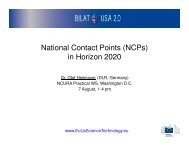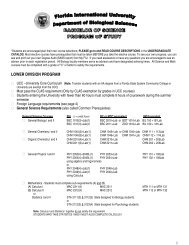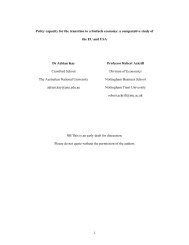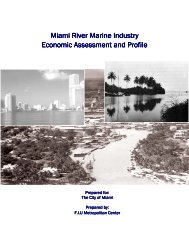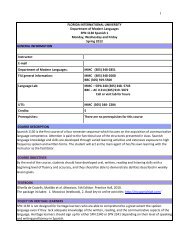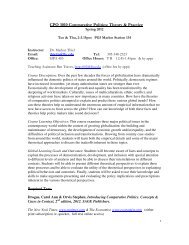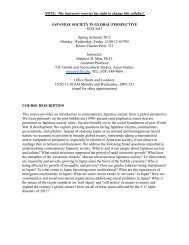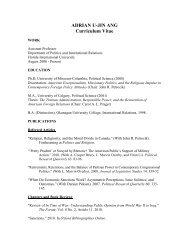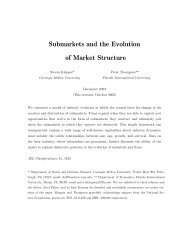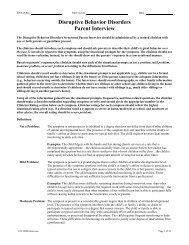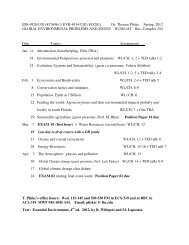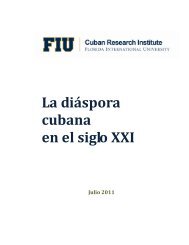Second Annual IFRI Forensic Science Symposium - College of Arts ...
Second Annual IFRI Forensic Science Symposium - College of Arts ...
Second Annual IFRI Forensic Science Symposium - College of Arts ...
You also want an ePaper? Increase the reach of your titles
YUMPU automatically turns print PDFs into web optimized ePapers that Google loves.
<strong>Second</strong> <strong>Annual</strong> <strong>IFRI</strong> <strong>Forensic</strong> <strong>Science</strong> <strong>Symposium</strong> • March 13 - 14, 2013<br />
12. Evidentiary value continued research <strong>of</strong> swabbing the front sight on handguns for DNA Analysis<br />
Sara Cole, Earl Gordon, Victor Morillo and Cara Lopez, Miami Dade Police Department<br />
Handguns obtained in criminal investigations are handled by numerous people prior to being impounded and submitted to the crime laboratory for<br />
DNA analysis. The DNA pr<strong>of</strong>iles obtained from swabs <strong>of</strong> these handguns are usually unresolvable mixtures <strong>of</strong> DNA with low statistical weight due to<br />
a low combined probability <strong>of</strong> inclusion (CPI). Suspects frequently carry their handguns inside their clothing in a manner that places the front sight <strong>of</strong><br />
the weapon in direct contact with their skin. This results in the transfer <strong>of</strong> epithelial cells to the front sight <strong>of</strong> the handgun, which can be swabbed for<br />
DNA analysis. The front sights, triggers and grips <strong>of</strong> 100 handguns were swabbed for DNA. The DNA on the swabs was typed using the AmpFISTR<br />
Indentifiler Plus® kit. When swabbing handguns for DNA, the front sight should be swabbed separately in addition to swabbing the trigger and grip.<br />
SESSION 2: DRUG ANALYSIS/TOXICOLOGY – THURSDAY 8:30 A.M.<br />
13. Broad-Based Screening <strong>of</strong> Bath Salts, Synthetic Cannabinoids, and Other Designer Drugs by LC-QQQ-MS and LC-QTOF-MS<br />
Anthony P. DeCaprio, Ana-Michelle Broomes, Joshua Z. Seither, Madeleine J. Swortwood,<br />
and Luis E. Arroyo-Mora, International <strong>Forensic</strong> Research Institute<br />
Designer drugs are synthetic compounds sold on the illicit market to evade law enforcement. Routine screening by immunoassay cannot detect the<br />
hundreds <strong>of</strong> designer drug entities that have been identified. Validated analytical methods are necessary to screen for and confirm their presence in ante-<br />
and post-mortem specimens. This presentation will describe work on the development <strong>of</strong> LC-MS/MS methods for rapid screening <strong>of</strong> designer drugs<br />
for forensic toxicology. We recently validated an LC-QQQ-MS/MS method for analysis <strong>of</strong> 32 designer drugs in serum and are expanding the screening,<br />
confirmation, and quantification capabilities to include ~300 designer drugs. While QQQ-MS is useful for known drug entities, exact mass analysis is an<br />
ideal approach for unknown or novel drugs. Consequently, we have also created a MS/MS spectral library for ~300 designer drugs using LC-QTOF-MS.<br />
It is hoped that these LC-MS based approaches will provide forensic toxicologists with new tools for high-throughput, comprehensive screens capable<br />
<strong>of</strong> identifying compounds across multiple designer drug classes with high sensitivity.<br />
14. Quantitation <strong>of</strong> Ethanol and Identification <strong>of</strong> Other Volatiles by<br />
Headspace Gas Chromatography with Simultaneous Flame Ionization and Mass Spectrometric Detection<br />
Nicholas B. Tiscione, Ilene Alford, Dustin Tate Yeatman, Xiaoqin Shan, Palm Beach County Sheriff’s Office<br />
Joe Kahl, Miami-Dade Medical Examiner Department<br />
Ethanol is the most frequently identified compound in forensic toxicology. Although confirmation involving mass spectrometry is desirable, relatively<br />
few methods have been published to date. Other volatiles are commonly abused as inhalants. The methods used for identification <strong>of</strong> those inhalants<br />
are generally non-specific if analyzed concurrently with ethanol or require an additional analytical procedure that employs mass spectrometry. A novel<br />
technique utilizing a capillary flow technology (CFT) splitter to simultaneously quantitate and confirm ethyl alcohol and identify inhalants by flameionization<br />
(FID) and mass spectrometric (MS) detection after headspace sampling and gas chromatographic separation is presented.<br />
15. Fast Detection Of Peroxide Explosives Using Planar Solid Phase Microextraction (PSPME)<br />
Coupled To Ion Mobility Spectrometers (IMS)<br />
Wen Fan, Mimy Young, José R. Almirall, International <strong>Forensic</strong> Research Institute<br />
A novel planar solid phase microextraction (PSPME) sorbent-coated disk has been developed and evaluated for the sampling and preconcentration <strong>of</strong><br />
volatile compounds in the headspace for either illicit drugs or explosives. In this research, the PSPME disks are used to preconcentrate the headspace<br />
odors <strong>of</strong> peroxide explosives such as triacetone triperoxide (TATP) and hexamethylene triperoxide diamine (HMTD) followed by the detection in various<br />
commercial <strong>of</strong>f-the-shelves ion mobility spectrometers (IMS) without further instrumental modifications. Quantitation <strong>of</strong> the retention capabilities were<br />
determined using TATP standards and static and dynamic headspace extractions were also performed and compared for PSPME extractions, in which<br />
low mg quantities <strong>of</strong> TATP were detected within 30 seconds <strong>of</strong> static mode sampling and less than 5 seconds in the dynamic mode sampling for PSPME-<br />
IMS. For HMTD, 2 h-16 h extractions have been performed in the headspace <strong>of</strong> a 100 mg <strong>of</strong> HMTD in a gallon jar and three peaks were detected in<br />
the MobileTrace IMS instruments in which one <strong>of</strong> these peaks alarm for the ammonia nitrate (AN)/urine nitrate (UN)/HMTD. The other two peaks remain<br />
unconfirmed so far.<br />
16. Submerged Remains: A Study on the Scent <strong>of</strong> Death<br />
Norma Iris Caraballo and Kenneth G. Furton, International <strong>Forensic</strong> Research Institute<br />
The decomposition process is highly influenced by the environment that surrounds the body. Factors, such as moisture, temperature, scavengers, and<br />
oxygen availability, can alter the manner in which a body decomposes and thus, the liberation <strong>of</strong> volatile organic compounds (VOCs). Previous studies<br />
have evaluated the effects <strong>of</strong> soil on the evolution <strong>of</strong> VOCs from decomposing remains; however, little to no research has been performed on the<br />
effects <strong>of</strong> water. Thus, this study used solid-phase microextraction coupled to gas chromatography-mass spectrometry to evaluate the VOCs that were<br />
released from decomposing submerged remains. The compounds detected ranged in chemical functionality and abundance, which was expected since<br />
mammalian decomposition is a process and not a single event. Differences and similarities between submerged and non-submerged remains will be<br />
discussed, as well as the impact that water has on the release <strong>of</strong> VOCs from decomposing submerged remains.<br />
Hosted by Florida International University | 13



